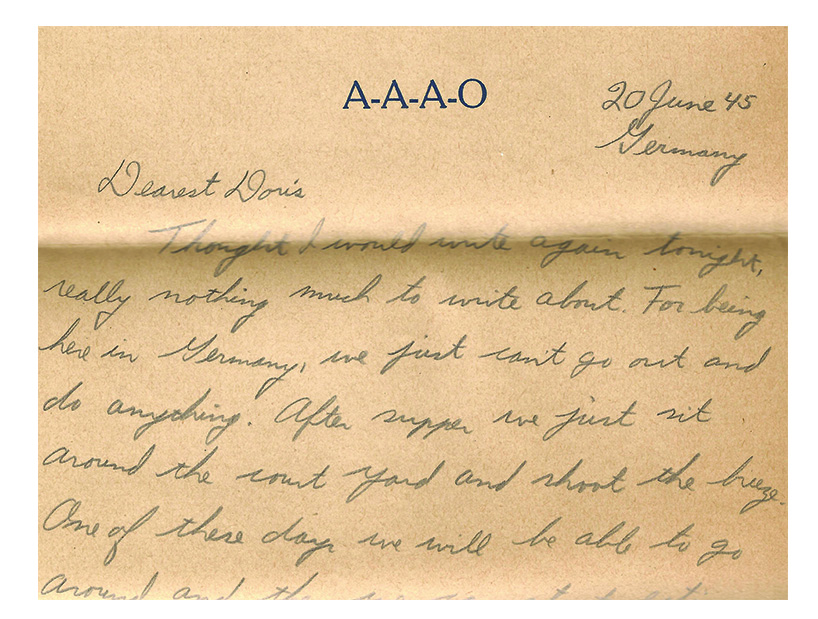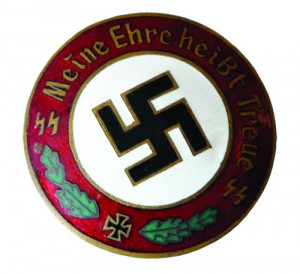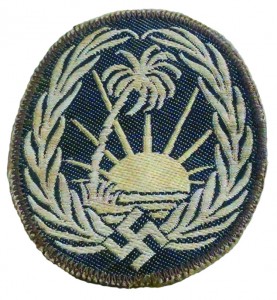My grandfather, Roger Elmer, served with the 39th Infantry Regiment, 9th Infantry Division, after V-E Day. His letters home had a logo, A-A-A-O, on the envelope and stationary. I’d appreciate any information regarding this logo. —Kevin Elmer, Chicago, Illinois
In 1943, while fighting in Sicily, the 39th Infantry Regiment acquired a new commander, Colonel Harry “Paddy” Flint, who was somewhat eccentric. “Paddy Flint is clearly nuts, but he fights well,” Patton once said. To galvanize his men’s morale, Flint introduced a new slogan: “Anything, Anytime, Anywhere—Bar Nothing.” He had the slogan, abbreviated to “AAA-0,”painted on helmets and vehicles, despite a ban on distinctive insignia that could alert enemy intelligence to American units’ identities. The men of the 39th proudly embraced the slogan, using it as their main identifier. A sniper killed Flint in July 1944 in Normandy, but the 39th Infantry Regiment emerged as one of the European Theater’s most successful American units, with three Presidential Unit Citations and awards from Belgium and France. —Brandon Stephens, Curator
This SS pin, which I acquired at an antique market in northern Italy, is slightly larger than a silver dollar with no markings on the back. I have several books on identifying World War II items, but this is in none of them. Thank you for any help you can provide. —Casey Martin, Aviano, Italy
Unfortunately, this appears to be a fake. No such pin was issued in Nazi Germany. The collector’s market for Nazi regalia began to grow shortly after the end of the war, and fakes have become increasingly common. Fakes of this type, which are similar to actual Nazi pins but entirely invented, are known as “fantasy” pins and were produced to be distinct enough from originals that the makers and sellers could get around antiforgery and fraud laws. The motto, “Meine Ehre heisst Treue” (“My honor is loyalty”), was the SS motto and has become popular with today’s neo-Nazi organizations. —Brandon Stephens
I was active duty United States Air Force and found this patch on a visit to Venice, Italy, in 1989. Originally thinking it was from the Africa Korps, I took it to an Antiques Roadshow visit in Tampa in 1999; folks there steered me to a German militaria expert who suggested the patch was not from the Africa Korps, but likely from one of the Nazi liaison groups to the Middle Eastern nations. But he couldn’t nail down the country or unit associated with the patch. Can you? —Mark T. Cripe, Tampa, Florida
The patch is that of Sonderverband 288, an extremely specialized unit that went on to serve under Erwin Rommel in North Africa. The unit, formed in 1941, included many Germans who before the war had been living in Africa, India, and the Middle East, and were fluent in a variety of languages. Sonderverband 288, which acted outside the Wehrmacht command structure, comprised some unusual entities, including a print shop and a group trained to use disguises to blend in with local populations.
Sonderverband 288’s mission was to exploit anticolonial sentiment in the Middle East and India to cut Britain off from its colonies and the natural resources they provided. Once British resistance in North Africa collapsed, the unit was to race through Egypt inciting unrest and capturing oil fields and other infrastructure—perhaps even taking the Suez Canal, to sever Britain’s shortcut to the Pacific and British India.
When the German offensive in North Africa faltered, Sonderverband 288—never more than 12 companies at its largest—was reorganized into a Panzergrenadier regiment and helped cover the German retreat. As an elite force, the regiment was often held in reserve to assist other units; despite mounting German losses, it fought with distinction. The unit was disbanded after the Axis collapse in Africa. Authentic patches of this type are quite rare. —Brandon Stephens
Have a World War II artifact you can’t identify? Write to footlocker@historynet.com
with the following:
•Your connection to the object and what you
know about it
•The object’s dimensions, in inches
•Several high-resolution digital photos taken close up and from varying angles. Pictures should be in color, and at least 300 dpi.
Unfortunately we can’t respond to every query, nor can we appraise value.
Originally published in the September/October 2015 issue of World War II magazine.







